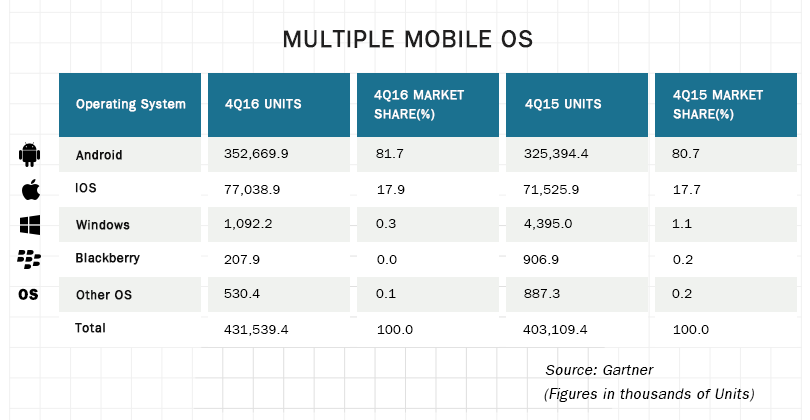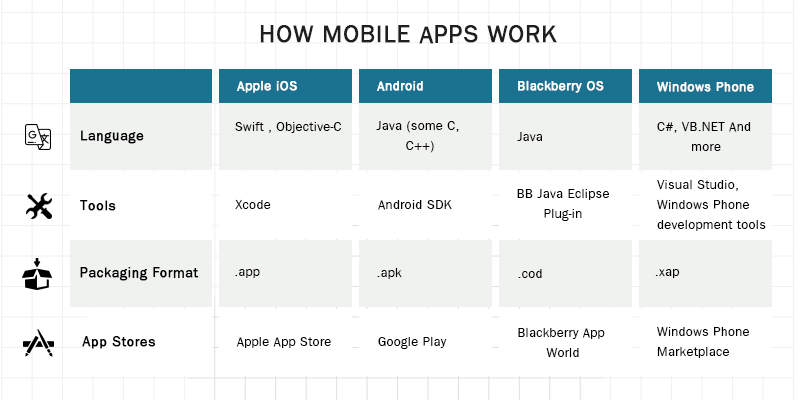Native vs Hybrid apps: When to use each one?
Ever since the first iPhone came into the market, it has made a huge difference to how information has reached a person. In many ways smartphones are a bridge of connectivity between a person – and the people he / she interacts with, the things he/ she interacts with and has become very interwoven with his or her lifestyle.
As the number of smartphone users increases to 4.77 billion this year, people are increasingly accessing data -say from your bank or online supermarket- through a variety of devices – tablets, desktops, and smartphones via a variety of operating systems. Companies are allowing employees BYOD (Bring Your Device to Work) to work with company data. So, developers there must ensure their designs are responsive and do not lose quality/ coherence when it is displayed in any device.
Multiple Mobile OS
Even though there are many smartphone operating systems (OS) in use, in terms of reach Android and Apple together command a large segment of users as seen by their 2016 sales figures.
How Mobile Apps Work
Mobile apps interact with your mobile operating system through proprietary APIs (application programming interface) that the operating system exposes to the app. These have unique features and functions that are typical to that OS. Low-level APIs allow the app access to images, microphone, GPS (Global Positioning System), keyboard and other hardware. High-level APIs allow access to processes/services such as making calls, managing the calendar etc.
Because of the lack of a common mobile platform, companies may have to develop multiple apps (with the same purpose) coded for each mobile platform, making the development and maintenance of these apps a long and expensive undertaking. Many companies simply can’t afford this approach because it is both time and cost-intensive.
How Native Apps are Created
Native apps are developed to be compatible only for a specific mobile operating system and cannot be installed in smartphones running a different OS.
All mobile OS vendors provide app developers something called software development kits(SDK). Developers write a source code program and create additional resources – such as images, audio segments and various OS-specific declaration files. Using the SDK, the source code is compiled to create a binary executable file which is packaged along with the images, audio etc. and made ready for distribution.
Apps are usually downloaded by visiting an app store, such as Apple’s App Store – though other methods also exist. Once the app has been installed in your phone – which means the binary executable files are downloaded directly to the device and stored locally – you can launch it. Upon initialization, the native app interfaces directly with the mobile operating system, without any intermediary or container.
Although the development process is often similar for different operating systems, the SDK is platform-specific and each mobile OS comes with its own unique tools.
How Hybrid Apps are Created
The hybrid approach combines native development with web technology. Apps are written simultaneously for multiple platforms – significant portions of them using cross-platform web technologies.
The web portion of the app can be either a web page that resides on a server or a set of HTML, JavaScript, CSS and media files packaged into the application code and stored locally on the device. The native portion of the app also known as the native container or wrapper is developed separately using different mobile application development platforms.
When compared with the prospect of learning an entirely new language/development environment in order to program other mobile OS apps, this gives web developers the easier option of coding in web code – and using programs such as PhoneGap or Titanium or Xamarin etc. for the wrapper.
Pros and Cons of Native apps
Native apps offer great user experience
Native apps offer rich and compelling user experiences. They are compatible with the other apps on the phone. A native app will feel familiar as the same intuitive gesturing (swiping, etc.) is required across apps and your learning curve will be small.
Native apps can really leverage the APIs and can access all the phone hardware/ software features while hybrid apps need plug-ins
Native apps can leverage the wider functionality of your mobile device, tapping into onboard hardware (such as GPS, camera, accelerometer) and software (such as picture/video gallery, file manager, and home screen widget areas). If your app requires integration with specific API’s, the best approach is to develop a native app.
For GUI, intensive or high CPU-usage apps it is better to go native
Native apps have extremely fast graphics and fluid animation. For graphic-intensive apps with animation and sound effects, this is the best choice.
Native apps are more secure
Native apps can leverage platform-specific built-in security features without plug-ins. In areas where security is important such as e-commerce and banking, native apps are a good choice.
Native apps work when offline and can send push notifications
Native apps are also more conducive to push notifications, and can be developed for use when there is no Wi-Fi or data. You can make use of push-notifications, alerting app users of new content or if their attention is required for other reasons. This is an opportunity to continually bring your audience back for more.
Native apps development/maintenance costs are high
For a native app to work across multiple devices, separate versions of the app are required. The multiple mobile platforms in the industry mean that developing, testing, porting and maintaining apps for different platforms costs money.
Native apps offer better performance
A native app uses a device’s native language, which speeds up the response time within the app so that means they have a speedier response time.
Native apps handle platform changes better
With native development, you can update your application to handle platform changes/take advantage of newly released features without counting on ongoing community support of your plug-ins
Pros and Cons of Hybrid apps
Hybrid apps can be developed faster to market if you’re in a hurry and with a consistent feel across devices
Because the same HTML or Javascript code is reused for differing operating systems and only a portion of the integrated native code needs to be rewritten, hybrid apps for multiple OS devices can be developed quickly.
Hybrid apps are easier to develop as there is only one common portable source code
Because of the cross-platform compatibility, hybrid apps can reach their target markets across all devices. With native apps, this isn’t the case – an app designed for an iPhone won’t work on Android, and vice versa.
Hybrid apps cost less
Hybrid apps are written once with HTML5 and Javascript, developers must make a few tweaks to the coding to work on multiple platforms, so hence it takes less effort to develop and hence costs less.
Hybrid apps can be slower in performance and less agile
A hybrid app can be less fast when compared to a native app because its speed depends upon the speed of a browser
Hybrid apps do not support an offline mode
It is not very practical to incorporate push notifications in hybrid apps which means that if you depend on content updates hybrid apps are not optimal.
Hybrid apps are less secure.
Hybrid apps use a lot of web content. If the JavaScript, or HTML code is not properly secured, attacks can occur. Hybrid apps also use plug-ins, which could have security vulnerabilities. Reverse engineering and man-in-the-middle attacks are also a concern for hybrid apps.
Hybrid apps need to reply on plug-ins to handle platform changes
When new versions of mobile platforms are released, in order to leverage new capabilities, you may again have to hire a developer for plug-ins to accommodate the update, or wait until the community creates one.
Hybrid apps are easier to update
Hybrid development allows seamless content updates directly from the web which means you don’t have to annoy your users by notifying them with updates all the time
Tradeoff
From the developing business’s point of view there is a tradeoff between the cost and time to develop and market the app vs. the user experience/ application functionality they can offer:
User experience is becoming paramount as not many users would keep an app on their phone that does not work. Typically, they attempt it very few times before giving up. People use apps for everything from business to pleasure and all of them will expect a great experience. Companies that see their mobile app being used a lot and in the long term will go native like Facebook did.
The hybrid approach provides a middle ground which, in many situations, is the best of both worlds, especially if the developer is targeting multiple operating systems.
Still have your concerns?
Your concerns are legit, and we know how to deal with them. Hook us up for a discussion, no strings attached, and we will show how we can add value to your operations!


